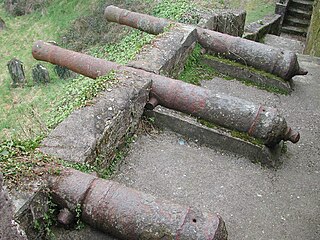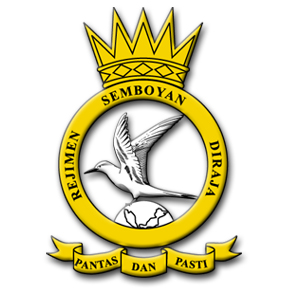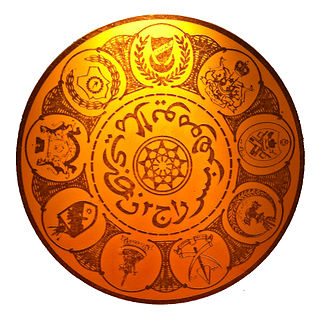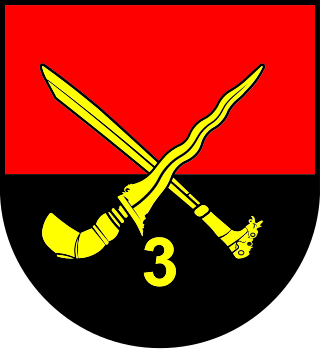
The Royal Regiment of Artillery, commonly referred to as the Royal Artillery (RA) and colloquially known as "The Gunners", is one of two regiments that make up the artillery arm of the British Army. The Royal Regiment of Artillery comprises thirteen Regular Army regiments, the King's Troop Royal Horse Artillery and five Army Reserve regiments.

In military organizations, an artillery battery is a unit or multiple systems of artillery, mortar systems, rocket artillery, multiple rocket launchers, surface-to-surface missiles, ballistic missiles, cruise missiles, etc., so grouped to facilitate better battlefield communication and command and control, as well as to provide dispersion for its constituent gunnery crews and their systems. The term is also used in a naval context to describe groups of guns on warships.

Negeri Sembilan is a state in Malaysia which lies on the western coast of Peninsular Malaysia. It borders Selangor on the north, Pahang in the east, and Malacca and Johor to the south.

The Malaysian Army is the land component of the Malaysian Armed Forces. Steeped in British Army traditions, the Malaysian Army does not carry the title ‘royal’ as do the Royal Malaysian Navy and the Royal Malaysian Air Force. Instead, the title is bestowed on selected army corps and regiments who have been accorded the honour by the Yang di-Pertuan Agong, who is the Supreme Commander of the Malaysian Armed Forces.

The Rejimen Askar Wataniah is the military reserve force of the Malaysian Army.

This article lists important figures and events in Malayan and Malaysian public affairs during the year 1963, together with births and deaths of significant Malaysians. The Federation of Malaya merged with Singapore, North Borneo, and Sarawak to form the Federation of Malaysia on 16 September.
This article lists important figures and events in Malayan public affairs during the year 1961, together with births and deaths of significant Malayans.

The Rejimen Semboyan Diraja is a combat support regiment of the Malaysian Army. It has the primary responsibility of establishing and maintaining secure military communications channels for the command and tactical elements of the Malaysian Army. It is also responsible for all electronic support, electronic warfare and early warning system for the Malaysian Army.

Royal Intelligence Corps is a Malaysian intelligence agency specialising in intelligence gathering, intelligence analysis, psychological warfare, surveillance, espionage, reconnaissance and counter-intelligence operations. It also manages the propaganda and counter-propaganda effort of the Malaysian Army.
Royal Army Engineers Regiment is a group combat support military units of the Malaysian Army that provides combat engineering and other engineering support to the Malaysian Army.
Zaini bin Mohd Said is a retired Malaysian Army general officer. His last rank was lieutenant general and his last position was as the Malaysian Army's field commander. Zaini is well known for his role in the surrender of Mohamed Amin Mohamed Razali, the leader of the Al-Mau'nah group that staged the arms heist at Battalion 304 Rejimen Askar Wataniah and the subsequent siege of the group at Bukit Jenalik, Sauk in Perak. Zaini was awarded the Seri Pahlawan Gagah Perkasa (SP), Malaysia's highest gallantry award, for his role during the Al Mau'nah siege.

Yamtuan, also known officially as Yang di-Pertuan Besar and unofficially as Grand Ruler, is the royal title of the ruler of the Malaysian state of Negeri Sembilan. The Grand Ruler of Negeri Sembilan is elected by a council of ruling chiefs in the state, or the Undangs. This royal practice has been followed since 1773. The Yamtuan Besar is elected from among the four leading princes of Negeri Sembilan ; the Undangs themselves cannot stand for election and their choice of a ruler is limited to a male Muslim who is Malay and also a "lawfully begotten descendant of Raja Radin ibni Raja Lenggang", the 4th Yamtuan.

The monarchies of Malaysia refer to the constitutional monarchy system as practised in Malaysia. The political system of Malaysia is based on the Westminster parliamentary system in combination with features of a federation.
Negeri Sembilan Malay is an Austronesian language spoken mainly in the Malaysian state of Negeri Sembilan and in northern Malacca in Alor Gajah. The language is spoken by the descendants of Minangkabau settlers from Sumatra, who have migrated to Negeri Sembilan since as early as the 14th century. It is often considered a variant or dialect of the Minangkabau language; lexical and phonological studies, however, indicate that it is more closely related to Standard Malay than it is to Minangkabau.

The Indonesian Malaysians are Malaysian citizens of Indonesian ancestry. Today, there are many Malaysian Malays who have lineage from the Indonesian archipelago and have played an important role in the history and contributed to the development of Malaysia, they have been assimilated with other Malay communities and are grouped as part of the foreign Malays or anak dagang in terms of race. The Malaysian census does not categorize ethnic groups from the Indonesian archipelago as a separate ethnic group, but rather as Bumiputera.

The 3rd Infantry Division is a division-sized combined arms formation of the Malaysian Army. Its headquarters are in Terendak Camp, Malacca, and it is in charge of defending the south of the Malay peninsula, which includes Malacca, Negeri Sembilan, Johor, and Pahang.

The Minangkabau Malaysians are citizens of the Malaysia whose ancestral roots are from Minangkabau of central Sumatra. This includes people born in the Malaysia who are of Minangkabau origin as well as Minangkabau who have migrated to Malaysia. Today, Minangkabau comprise about 989,000 people in Malaysia, and Malaysian law considers most of them to be Malays. They are majority in urban areas, which has traditionally had the highest education and a strong entrepreneurial spirit. The history of the Minangkabau migration to Malay peninsula has been recorded to have lasted a very long time. When the means of transportation were still using the ships by down the rivers and crossing the strait, many Minang people migrated to various regions such as Negeri Sembilan, Malacca, Penang, Kedah, Perak, and Pahang. Some scholars noted that the arrival of the Minangkabau to the Malay Peninsula occurred in the 12th century. This ethnic group moved in to peninsula at the height of the Sultanate of Malacca, and maintains the Adat Perpatih of matrilineal kinships system in Negeri Sembilan and north Malacca.
















